Themed collection CRISPR Biomaterials

Approaches towards biomaterial-mediated gene editing for cancer immunotherapy
Non-viral carriers must cross multiple extra- and intracellular delivery barriers to deliver functional gene editing cargo. Leading non-viral biomaterials and CRISPR technology can be integrated to advance immune cell gene editing to treat cancer.

Biomater. Sci., 2022,10, 6675-6687
https://doi.org/10.1039/D2BM00806H
Nanoscale metal–organic frameworks for the intracellular delivery of CRISPR/Cas9 genome editing machinery
The discovery of CRISPR/Cas9 genome-editing technology enables the precise manipulation of mammalian DNA sequences for treating genetic disorders.
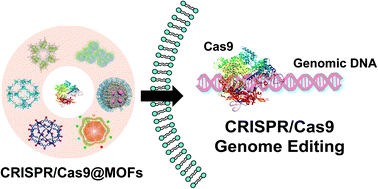
Biomater. Sci., 2021,9, 7024-7033
https://doi.org/10.1039/D1BM00790D
Harnessing lipid nanoparticles for efficient CRISPR delivery
Lipid-based nanomaterials have shown to mediate specific and effective CRISPR delivery in vivo for the treatment of various diseases, including cancers, genetic disorders and infectious diseases.
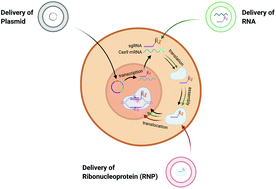
Biomater. Sci., 2021,9, 6001-6011
https://doi.org/10.1039/D1BM00537E
Functionalized extracellular nanovesicles as advanced CRISPR delivery systems
This review highlights the advances of functional extracellular nanovesicles in CRISPR delivery, including their cellular entry pathways, functionalization techniques, and the challenges and strategies pivotal for clinical translation.

Biomater. Sci., 2024,12, 3480-3499
https://doi.org/10.1039/D4BM00054D
Synthetic nanoparticles for the delivery of CRISPR/Cas9 gene editing system: classification and biomedical applications
The CRISPR/Cas9 systems contain three modes: I. plasmid DNA encoding both Cas9 and sgRNA; II. Cas9 mRNA and sgRNA; III. Cas9 protein and sgRNA. We summarized the application of the synthesized nanomaterials for delivery the CRISPR/Cas9 systems.
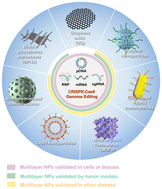
Biomater. Sci., 2023,11, 5361-5389
https://doi.org/10.1039/D3BM00788J
Recent advances in stimuli-responsive polymeric carriers for controllable CRISPR/Cas9 gene editing system delivery
Stimulus-responsive polymer delivery vectors with modifiable architectures can load and deliver CRISPR gene editing systems in a controlled manner, which improves the effectiveness of gene editing towards potential clinical disease treatment.

Biomater. Sci., 2023,11, 5078-5094
https://doi.org/10.1039/D3BM00529A
Biomaterial-assisted targeted and controlled delivery of CRISPR/Cas9 for precise gene editing
Development of a novel biomaterial-based CRISPR-Cas9 system for the precise control of genome editing.
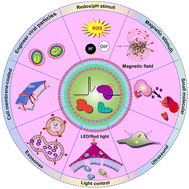
Biomater. Sci., 2023,11, 3762-3783
https://doi.org/10.1039/D2BM01636B
Biogenic materials for CRISPR delivery and therapeutics
Biogenic materials, including viruses, bacteria, cells, and bioactive substances, are discussed for CRISPR delivery and therapeutics.

Biomater. Sci., 2023,11, 3016-3033
https://doi.org/10.1039/D2BM02169B
Cell-derived extracellular vesicles for CRISPR/Cas9 delivery: engineering strategies for cargo packaging and loading
This review summarizes the use of cell-derived vesicles, including EVs and exosomes for the delivery of CRISPR/Cas tools, with a focus on the state-of-the-art engineering strategies to realize efficient cargo packaging and loading.
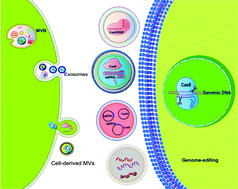
Biomater. Sci., 2022,10, 4095-4106
https://doi.org/10.1039/D2BM00480A
Pre-clinical non-viral vectors exploited for in vivo CRISPR/Cas9 gene editing: an overview
Non-viral delivery technologies for efficient in vivo Clustered Regulatory Interspaced Short Palindromic Repeats (CRISPR/Cas9) gene editing.
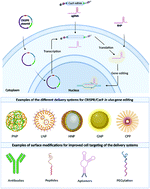
Biomater. Sci., 2022,10, 3410-3432
https://doi.org/10.1039/D1BM01452H
Non-viral delivery of the CRISPR/Cas system: DNA versus RNA versus RNP
Delivery of the CRISPR/Cas9 system can be realized by utilizing different biomolecular formats, each featuring individual characteristics, advantages and challenges.
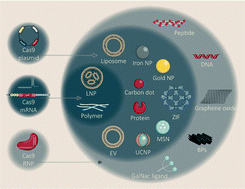
Biomater. Sci., 2022,10, 1166-1192
https://doi.org/10.1039/D1BM01658J
External stimuli-responsive nanoparticles for spatially and temporally controlled delivery of CRISPR–Cas genome editors
In this review, we summarize the state-of-the-art non-viral vectors that exploit external stimuli (i.e., light, magnetic field, and ultrasound) for spatially and temporally controlled genome editing and their in vitro and in vivo applications.

Biomater. Sci., 2021,9, 6012-6022
https://doi.org/10.1039/D1BM00558H
Revisiting gene delivery to the brain: silencing and editing
Neurodegenerative disorders, ischemic brain diseases, and brain tumors are debilitating diseases that severely impact a person's life and could possibly lead to their demise if left untreated.

Biomater. Sci., 2021,9, 1065-1087
https://doi.org/10.1039/D0BM01278E
Intracellular regulation of zinc by metal–organic framework-mediated genome editing for prostate cancer therapy
The preparation process of Cas9@ZIF8-DUPA nanoparticles and the anti-tumour mechanism for PCa.

Biomater. Sci., 2023,11, 7556-7567
https://doi.org/10.1039/D3BM00002H
Optimization of precision nanofiber micelleplexes for DNA delivery
Several factors important for understanding the formation and biological activity of nanofiber micelleplexes are examined and optimized in this work. These studies should inform the future design of more advanced polymeric DNA delivery systems.

Biomater. Sci., 2023,11, 3512-3523
https://doi.org/10.1039/D2BM02014A
Efficient CRISPR-Cas9-based knockdown of RUNX2 to induce chondrogenic differentiation of stem cells
Effective knockdown of the RUNX2 gene by CRISPR-Cas9-based nanoparticles (CASP-NPs) is even more effective in chondrogenic differentiation.

Biomater. Sci., 2022,10, 514-523
https://doi.org/10.1039/D1BM01716K
Phenylboronic acid-functionalized polyaminoglycoside as an effective CRISPR/Cas9 delivery system
One tumor-targeting, phenylboronic acid-functionalized polyaminoglycoside (SS-HPT-P) was proposed as a safe and effective CRISPR/Cas9 delivery system for the treatment of carcinoma.

Biomater. Sci., 2021,9, 7104-7114
https://doi.org/10.1039/D1BM00185J
An engineered exosome for delivering sgRNA:Cas9 ribonucleoprotein complex and genome editing in recipient cells
CRISPR-Cas9 components delivered by engineered exosomes achieve genome editing in recipient cells.
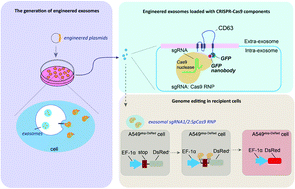
Biomater. Sci., 2020,8, 2966-2976
https://doi.org/10.1039/D0BM00427H
About this collection
This collection on CRISPR Biomaterials seeks to fuel the development in the field of biomaterials for CRISPR/Cas-based genome editing components, and provide an overview of the emerging delivery technologies and recent progresses for exploiting biomaterials for CRISPR/Cas systems. The collection covers the principles of biomacromolecule (including plasmid, mRNA, ribonucleoprotein) delivery and gene editing, examine recent advances and challenges in both non-viral and viral delivery methods, and exemplify the status of related applications and clinical trials along with the current challenges and future prospects of the delivery technologies for CRISPR system for clinical translations.
Guest Edited by Yuan Ping (Zhejiang University, China), Ming Wang (Institute of Chemistry, Chinese Academy of Sciences, China) and Qiaobing Xu (Tufts University, USA).